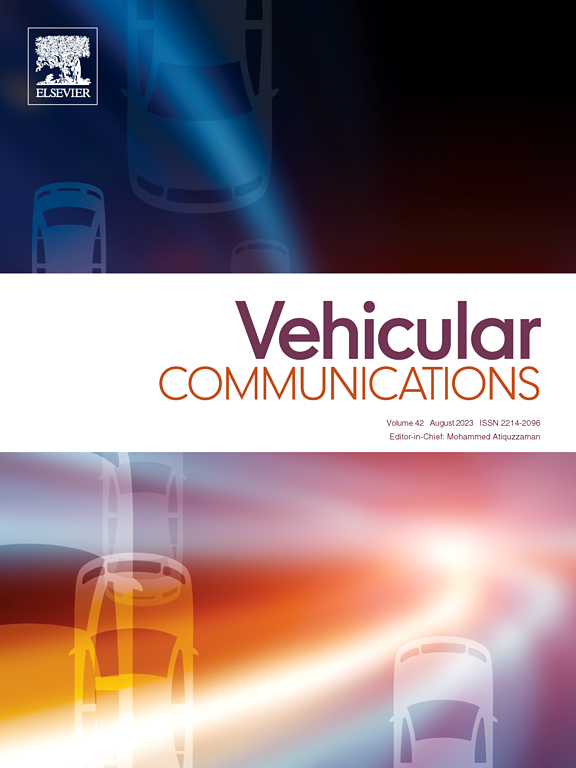VANET环境下基于密集胶囊堆叠自编码器模型的DDoS攻击检测与路由混合最优带宽分配
IF 6.5
2区 计算机科学
Q1 TELECOMMUNICATIONS
引用次数: 0
摘要
车辆自组织网络(VANET)是智能交通的绝佳工具,因为它可以提高效率、管理、交通安全和舒适度。针对VANET基础设施的分布式拒绝服务(DDoS)攻击可能会导致碰撞和死亡,从而危及交通安全。因此,在将vanet集成到智能交通网络的同时,必须解决相关的安全问题。本文提供了一种有效的路由优化和基于深度学习的攻击检测方法。输入数据首先从可公开访问的数据集中收集。然后,开发了一种独特的密集胶囊堆叠自动编码器(DCSAE)网络,用于检测输入中是否存在DDoS攻击。在这里,检测方法是通过胶囊网络与堆叠自动编码器的杂交实现的。此外,采用改进的火鹰优化算法(IFHOA)对所提出的检测技术进行了细化。一旦发现攻击,就使用混合䲟鲸优化(HRWO)方法分配带宽。最后,利用改进的鱼鹰优化(IOO)方法,综合考虑能源使用、延迟和下降等因素,确定更好的路由路径。利用DDoS SDN数据集实现该方法。在结果部分,将建议的技术与现有方法在召回率、准确率、精密度、F1分数、平均绝对误差(MAE)、包投递率(PDR)、包丢包率(PLR)和能量消耗方面进行了比较。该模型的准确率为94.07%,准确率为94.2%,召回率为93.33%,f1得分为93.88%。该模型的MAE为0.132,时延为4812.976,能耗为40.13%,PDR为95.1805,PLR为3.6816%。本文章由计算机程序翻译,如有差异,请以英文原文为准。
Dense capsule stacked auto-encoder model based DDoS attack detection and hybrid optimal bandwidth allocation with routing in VANET environment
The vehicle ad hoc network, or VANET, is a fantastic tool for smart transport since it improves efficiency, management, traffic safety, and comfort. Distributed Denial of Service (DDoS) attacks on VANET infrastructure have the potential to compromise traffic safety by causing collisions and fatalities. Therefore, while integrating VANETs into intelligent transport networks, the pertinent security issues must be addressed. This paper provides an efficient routing optimization as well as a deep learning-based attack detection approach. The input data are first collected from publically accessible datasets. After that, a unique Dense Capsule Stacked Auto Encoder (DCSAE) network is developed to detect the presence of DDoS attacks in the inputs. Here, the detection method is enabled by the hybridization of the Capsule Network with a Stacked Auto Encoder. Moreover, the Improved Fire Hawks Optimization Algorithm (IFHOA) is employed to refine the proposed detection technique. Once assaults have been discovered, bandwidth is allocated using the Hybrid Remora Whale Optimization (HRWO) approach. Finally, an Improved Osprey Optimization (IOO) method is utilized to identify a better routing path by taking into account aspects such as energy usage, delay, and drop. The DDoS SDN dataset is employed to implement the proposed method. In the results section, the suggested technique is compared to existing methods in terms of recall, accuracy, precision, F1 score, Mean Absolute Error (MAE), Packet Delivery Ratio (PDR), Packet Loss Ratio (PLR), and consumption of energy. The proposed model achieved an accuracy of 94.07 % while achieving the precision, recall, and F1-score of 94.2 %, 93.33 %, and 93.88 %, respectively. The model achieved the MAE of 0.132, delay of 4812.976, energy consumption of 40.13 %, PDR of 95.1805, and PLR of 3.6816 %, respectively.
求助全文
通过发布文献求助,成功后即可免费获取论文全文。
去求助
来源期刊

Vehicular Communications
Engineering-Electrical and Electronic Engineering
CiteScore
12.70
自引率
10.40%
发文量
88
审稿时长
62 days
期刊介绍:
Vehicular communications is a growing area of communications between vehicles and including roadside communication infrastructure. Advances in wireless communications are making possible sharing of information through real time communications between vehicles and infrastructure. This has led to applications to increase safety of vehicles and communication between passengers and the Internet. Standardization efforts on vehicular communication are also underway to make vehicular transportation safer, greener and easier.
The aim of the journal is to publish high quality peer–reviewed papers in the area of vehicular communications. The scope encompasses all types of communications involving vehicles, including vehicle–to–vehicle and vehicle–to–infrastructure. The scope includes (but not limited to) the following topics related to vehicular communications:
Vehicle to vehicle and vehicle to infrastructure communications
Channel modelling, modulating and coding
Congestion Control and scalability issues
Protocol design, testing and verification
Routing in vehicular networks
Security issues and countermeasures
Deployment and field testing
Reducing energy consumption and enhancing safety of vehicles
Wireless in–car networks
Data collection and dissemination methods
Mobility and handover issues
Safety and driver assistance applications
UAV
Underwater communications
Autonomous cooperative driving
Social networks
Internet of vehicles
Standardization of protocols.
 求助内容:
求助内容: 应助结果提醒方式:
应助结果提醒方式:


